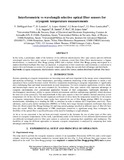Mostrar el registro sencillo del ítem
Interferometric vs wavelength selective optical fiber sensors for cryogenic temperature measurements
| dc.creator | Miguel Soto, Verónica de | es_ES |
| dc.creator | Leandro González, Daniel | es_ES |
| dc.creator | López Aldaba, Aitor | es_ES |
| dc.creator | Beato López, Juan Jesús | es_ES |
| dc.creator | Pérez de Landazábal Berganzo, José Ignacio | es_ES |
| dc.creator | Auguste, Jean-Louis | es_ES |
| dc.creator | Jamier, Raphael | es_ES |
| dc.creator | Roy, Philippe | es_ES |
| dc.creator | López-Amo Sáinz, Manuel | es_ES |
| dc.date.accessioned | 2019-09-16T12:09:59Z | |
| dc.date.available | 2019-09-16T12:09:59Z | |
| dc.date.issued | 2017 | |
| dc.identifier.citation | V. DeMiguel-Soto, D. Leandro, A. Lopez-Aldaba, J. J. Beato-López, J. I. Pérez-Landazábal, J.-L. Auguste, R. Jamier, P. Roy, and M. Lopez-Amo 'Interferometric vs. wavelength selective optical fiber sensors for cryogenic temperature measurements', Proc. SPIE 10323, 25th International Conference on Optical Fiber Sensors, 1032337 (23 April 2017); https://doi.org/10.1117/12.2264889 | en |
| dc.identifier.issn | 0277-786X | |
| dc.identifier.uri | https://hdl.handle.net/2454/34828 | |
| dc.description.abstract | In this work, a preliminary study of the behavior of two different interferometric fiber optic sensors and two different wavelength selective fiber optic sensors is performed. A photonic cristal fiber Fabry-Pérot interferometer, a Sagnac interferometer, a commercial fiber Bragg grating (FBG) and a π-phase shifted fiber Bragg grating interrogated in a random distributed feedback fiber laser are analyzed. A comparison of their sensitivities and resolutions is carried out to analyze their performance as sensors for cryogenic temperatures, taking into account their advantages and drawbacks. | en |
| dc.description.sponsorship | Financial support from the Spanish Comisión Interministerial de Ciencia y Tecnología within projects TEC2013-47264-C2-2-R and TEC2016-76021-C2-1-R and the FEDER funds are acknowledged. | en |
| dc.format.extent | 4 p. | |
| dc.format.mimetype | application/pdf | en |
| dc.language.iso | eng | en |
| dc.publisher | SPIE | en |
| dc.relation.ispartof | 25th International Conference on Optical Fiber Sensors, edited by Youngjoo Chung… [et al.], Proc. of SPIE Vol. 10323, 1032337 | en |
| dc.rights | © 2017 SPIE. One print or electronic copy may be made for personal use only. Systematic reproduction and distribution, duplication of any material in this publication for a fee or for commercial purposes, or modification of the contents of the publication are prohibited. | en |
| dc.subject | Cryogenic temperature | en |
| dc.subject | Interferometric sensor | en |
| dc.subject | Optical fiber sensor | en |
| dc.subject | Random distributed feedback fiber lasers | en |
| dc.title | Interferometric vs wavelength selective optical fiber sensors for cryogenic temperature measurements | en |
| dc.type | info:eu-repo/semantics/conferenceObject | en |
| dc.type | Contribución a congreso / Biltzarrerako ekarpena | es |
| dc.contributor.department | Ingeniería Eléctrica y Electrónica | es_ES |
| dc.contributor.department | Ingeniaritza Elektrikoa eta Elektronikoa | eu |
| dc.contributor.department | Física | es_ES |
| dc.contributor.department | Fisika | eu |
| dc.contributor.department | Institute for Advanced Materials and Mathematics - INAMAT2 | es_ES |
| dc.rights.accessRights | info:eu-repo/semantics/openAccess | en |
| dc.rights.accessRights | Acceso abierto / Sarbide irekia | es |
| dc.identifier.doi | 10.1117/12.2264889 | |
| dc.relation.projectID | info:eu-repo/grantAgreement/MINECO//TEC2013-47264-C2-2-R/ES/ | en |
| dc.relation.projectID | info:eu-repo/grantAgreement/ES/1PE/TEC2016-76021 | en |
| dc.relation.publisherversion | https://doi.org/10.1117/12.2264889 | en |
| dc.type.version | info:eu-repo/semantics/publishedVersion | en |
| dc.type.version | Versión publicada / Argitaratu den bertsioa | es |
Ficheros en el ítem
Este ítem aparece en la(s) siguiente(s) colección(ones)
-
Comunicaciones y ponencias de congresos DF - FS Biltzarretako komunikazioak eta txostenak [1]
-
Comunicaciones y ponencias de congresos INAMAT2 - INAMAT2 biltzarretako komunikazioak eta txostenak [12]
-
Comunicaciones y ponencias de congresos DIEE - IEES Biltzarretako komunikazioak eta txostenak [191]
-
Comunicaciones y ponencias de congresos - Biltzarrak eta Argitalpenak [804]


